Bamboo has a well-deserved reputation for being one of the fastest-growing plants on earth. Indeed, some tropical varieties can grow more than a meter a day in the growing season. Pull up a cozy chair and you can actually watch it grow.
Running bamboo has earned a particularly nasty reputation for its growth habits. That’s because those rhizome roots spread like crazy. Although in this case, you can’t actually watch them grow. But it’s led many gardeners to wonder whether planting bamboo might not be such a good idea after all.
What is a running bamboo?
Among the 90 genera and roughly 1,500 species of bamboo, we like to divide them into two simple categories. Basically, we have runners and clumpers. The most widespread genera of runners are the Phyllostachys and Pleioblastus. Runners generally perform better in temperate climates.
Running bamboo has a distinctively vigorous rhizome root system. The monopodial or leptomorph rhizomes tend to grow horizontally, parallel to the ground, spreading outward and overtaking an area. As the horizontal rhizomes extend outward, they eventually produce fresh shoots, new culms, growing upward. Sometimes, but not always, these monopodial bamboos can spread very aggressively. They can definitely become invasive. They can tear up your lawn, crawl under fences, and become very difficult to remove.
You might not notice this aggressive growth habit right away, but in time you will. In fact, there is an old adage which perfectly describes the behavior of running bamboo. “The first year it sleeps, the second year it creeps, the third year it leaps.” It typically takes a full season or entire year for a new bamboo plant to get established. Then the rhizomes begin to spread underground and get a solid foothold. Finally, the new shoots begin emerging from this underground network, and you realize that the bamboo is a real force of nature.
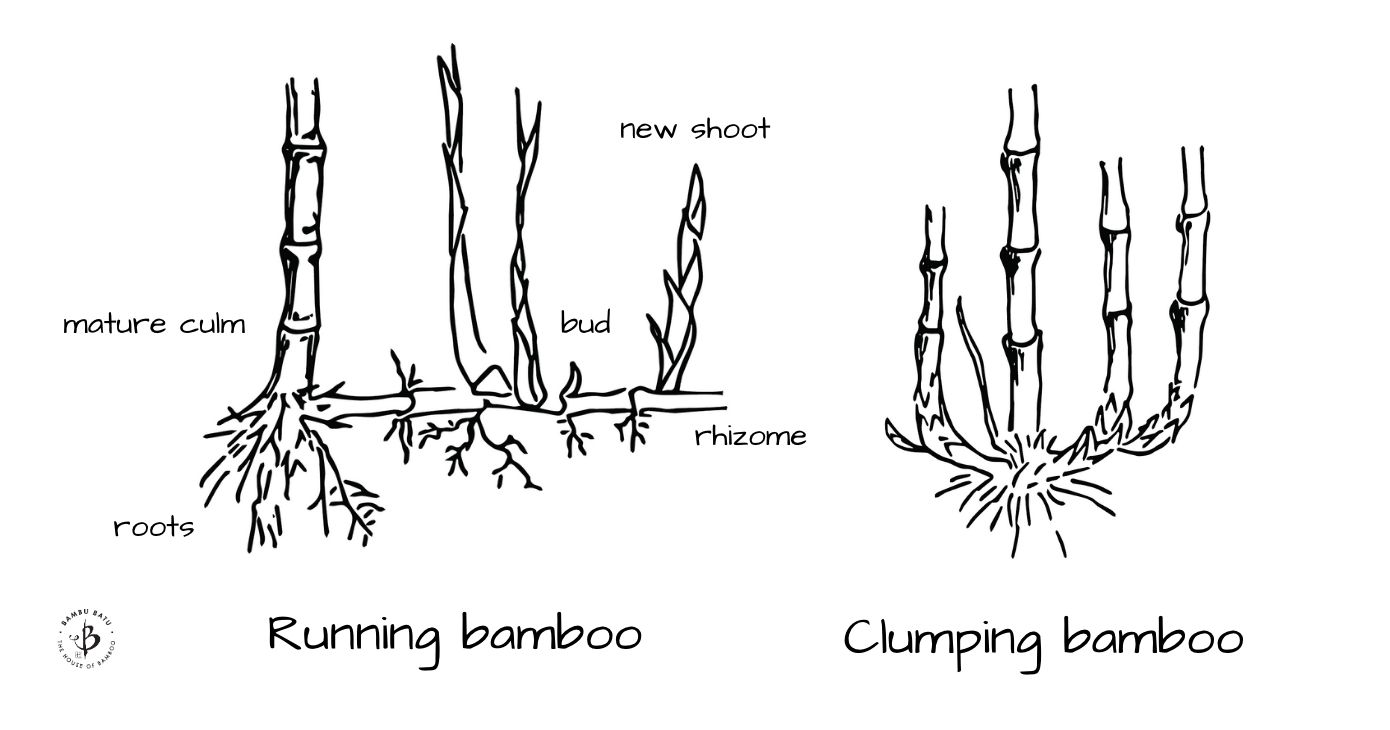
Clumping bamboos, by contrast, are happier in the tropical and subtropical climes. Bambusa is the most prevalent genus of clumping bamboo. Like all bamboo, clumpers also have rhizome roots, but they are what’s called sympodial, or pachymorph. These sympodial rhizomes mostly grow close together, branching out often, to create a tight cluster of culms. It’s unlikely for a clumping bamboo to become invasive.
Why would you want to plant running bamboo?
With so much potential to be invasive and disruptive, why would anyone want to plant a running bamboo? That’s a very good question. But as it turns out, there are a few good reasons to plant a runner instead of a clumper.
Definitely check out our article on the 10 Best Bamboos for your Garden.
Climate
When selecting anything to plant in your garden, one of the chief factors will always be the climate. And when you think of bamboo, you probably think of places like Hawaii, Southeast Asia and Central America. In other words, the tropics. Indeed, bamboo thrives in these regions, especially the clumping varieties of bamboo.
But most of us don’t live in the tropics. And for those of us who do, there’s usually already plenty of bamboo around. But for the rest of us, we need something more adaptable. No problem. There are many varieties of bamboo indigenous to the more temperate zones of Asia, including China, Korea and Japan. And as it happens, these temperate bamboos usually belong in the running category.
The largest genus of these more temperate Chinese bamboos is Phyllostachys. They do very well in a range of climates, and they are definitely runners. Nurseries throughout most U.S. states and Europe can sell Phyllostachys and other temperate runners and feel good knowing they will probably thrive.
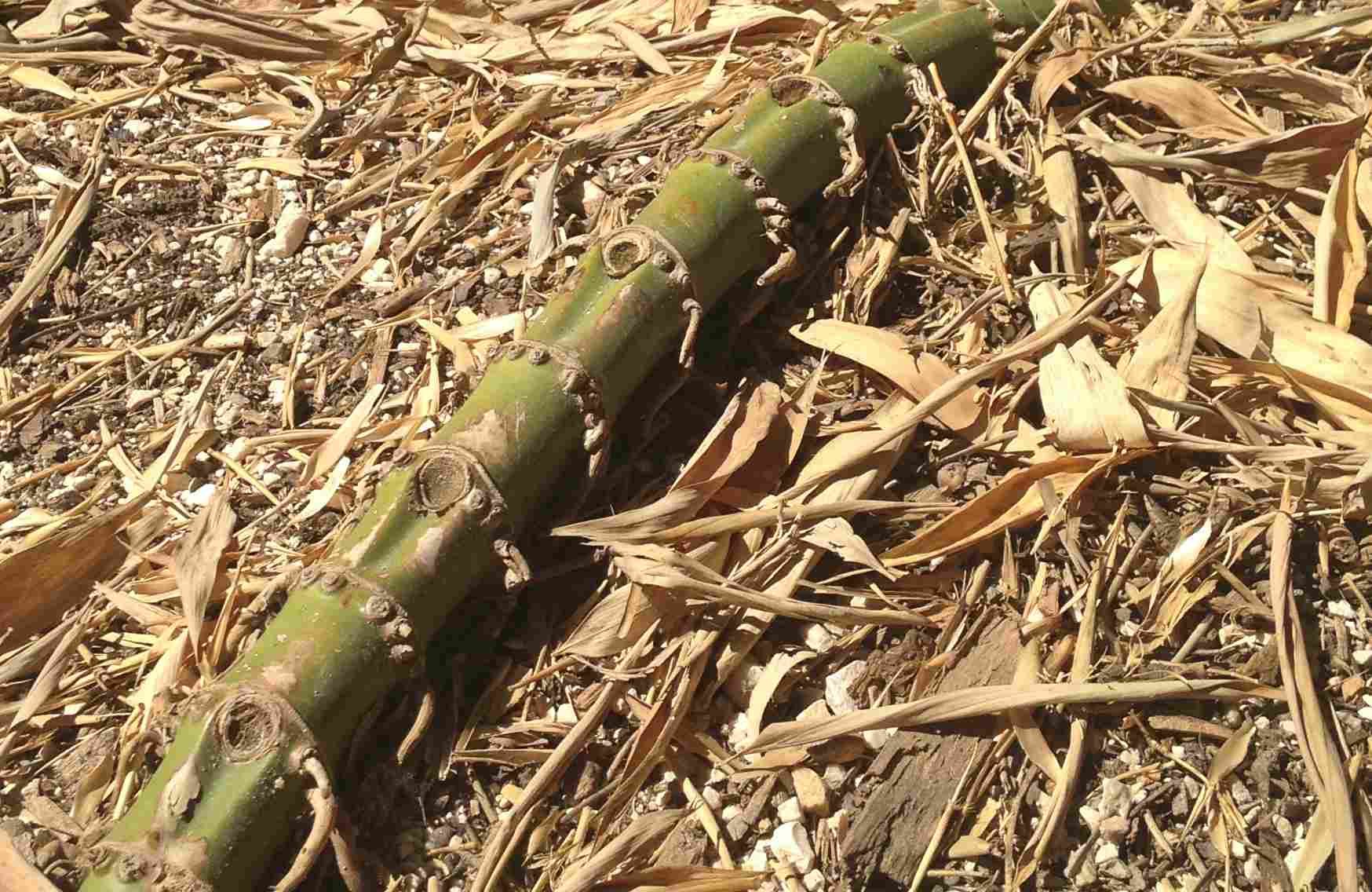
So planting a running bamboo actually makes a lot of sense if you live in a more temperate zone. But these runners aren’t the only varieties that can grow in a cool climate. If you’re living outside the tropics and trying to avoid planting a runner, keep an eye out for varieties of Bambusa like Oldhammi, genus Chusquea, and most any bamboo from the genus Fargesia.
You might also have a look at our article on Cold Hardy Bamboos.
NOTE: Phyllostachys is also one of the easier bamboo varieties to identify. Look for the distinctive grooves that grow along the length of the internodes, alternating from one side to the other.
Fast Growing
As we have seen, bamboo’s vigorous growth habit can be a double-edged sword. But many growers are looking for something that will really display its vegetative might. Some gardeners just have a lot of respect for the great vitality and tenacity of bamboo and want to see it grow in full force. But usually they have more practical intentions, like trying to fill a large area quickly.
Bamboo makes for an excellent privacy screen, and many people are in a hurry to establish their privacy. If you want a tall hedge to grow along your fence line, bamboo is an attractive option. And if you want it to cover the property line and fill in quickly, an aggressive runner can be even more appealing.
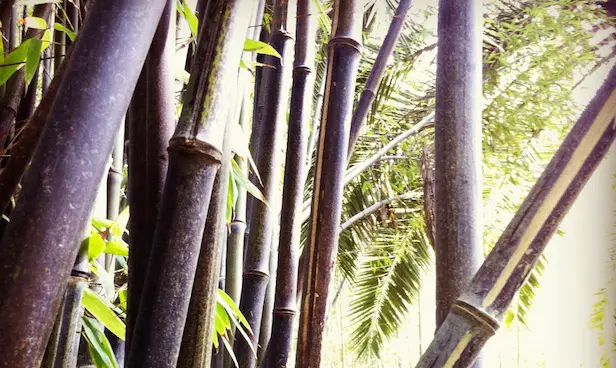
Aesthetic Features
In many cases, gardeners will plant bamboo for specific aesthetic features. Whether to beautify the garden or to harvest the attractive poles, striped bamboo and black bamboo are very desirable. Phyllostachys nigra, better known simply as black bamboo, is one of the most popular species of all, due to its rich, dark color. The dried poles are especially attractive for crafts and light construction.
Certain other varieties of running bamboo also have very attractive features, like long and elegant poles. And for those who enjoy combining a medley of different bamboo species, they will have a hard time completing their landscape without at least one or two runners in the mix.
How can I maintain a running bamboo?
So you’ve decided to plant some running bamboo in your yard. Must you concede defeat and consign yourself to be overrun with woody grasses? Absolutely not! It’s not as easy as plucking daisies, but there are ways to contain running bamboos and keep them in check.
Check out our recommended list of bamboo gardening tools and supplies.
Containers
There are numerous types of containers you can use to prevent a running bamboo from taking over your garden. Planting bamboo in a pot is certainly one option, but be aware that a running bamboo will get root bound very quickly, even in a good sized pot.
I like to use half wine barrels (or whiskey barrels, depending what part of the country you’re in.) They have a more natural look in the garden, compared to your big black plastic pots from the nursery. And they’re spacious. Even so, I find myself un-potting the bamboo almost every year to split the rootball into three or four pieces. (Another advantage of running bamboo is that it’s pretty easy to propagate.)
Keep in mind, if you place your pot directly on top of soil, the roots will quickly find their way through the drain hole and into the earth. Be sure to place a stepping stone or something under the pot, or set it on a patio. Also avoid ceramic pots, as they are liable to burst from the expanding roots. And never use a pot that gets narrower at the top; you’ll never get your bamboo out without breaking it.
Root barriers
Your best bet is probably a high grade root barrier. You can order heavy duty plastic barrier and bury it around the perimeter of your bamboo area. This can be a very reliable system, but it’s not fool proof. Be sure to get the barrier at least two feet underground (unless you’re planting a dwarf variety).
Our best recommendation is the DeepRoot Bamboo Barrier, 30″ deep by 100 ft roll., which is available at Amazon.
And keep an eye on it. When they feel the urge to spread out, those monopodial rhizomes can be relentless. If there’s even the tiniest gap in your root barrier, they’ll burrow into it. And if there’s a thick layer of mulch concealing the top of the root barrier, the roots might easily crawl over it.
A lot of times, people move into a house and inherit someone else’s poorly planned bamboo garden. This could require some serious work to remove masses of roots. You can do some very heavy root pruning in this case, and then try to install a root barrier. But sometimes you just have to go Rambo: Dig a trench and fill it with concrete.
Root pruning
One of the most important things you can do to keep a running bamboo under control is simply monitor it closely. Dig around the base of the plant a couple times a year and see what’s happening. You can’t always tell just by watching what the bamboo is doing above ground.
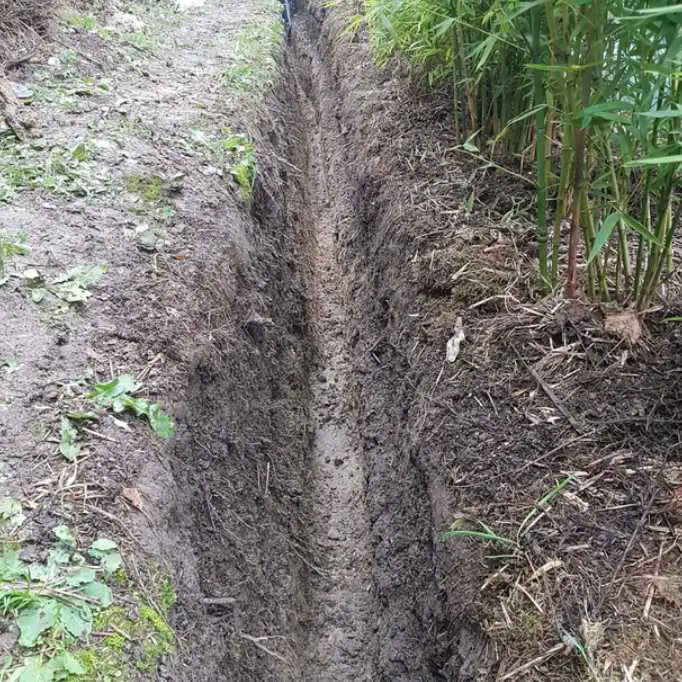
Also, see my in-depth article on digging a containment trench around your bamboo.
When you find bamboo rhizomes racing away from the main grove, cut them back. If you’re dealing with a mature and well-established bamboo plant, this could be a serious chore. Make sure you have the right tools, including a good spade, some sharp clippers, and a compact hand saw.
You might even need a Sawsall or other reciprocating saw, to really get in there. We recommend Makita’s Cordless Recipro Saw Kit, sold complete with saw blades and an extra battery, and available for quick delivery from Amazon.
Further Reading
To learn more about the wonders of bamboo in your garden and around the world, be sure to take a look at some of these other articles.
- What’s so great about bamboo?
- How to choose the best bamboo
- Should I plant a bamboo hedge?
- How to Grow Bamboo: The Ultimate Guide
- 20 Best Bamboo Gardens in the World
- Bamboo Symbols in Mythology and Folklore
NOTE: The article first appeared in June 2019, most recently updated in May 2023.
FEATURE PHOTO: Leaping rhizome of Phyllostachys viridiglaucescens (Photo by Fred Hornaday)
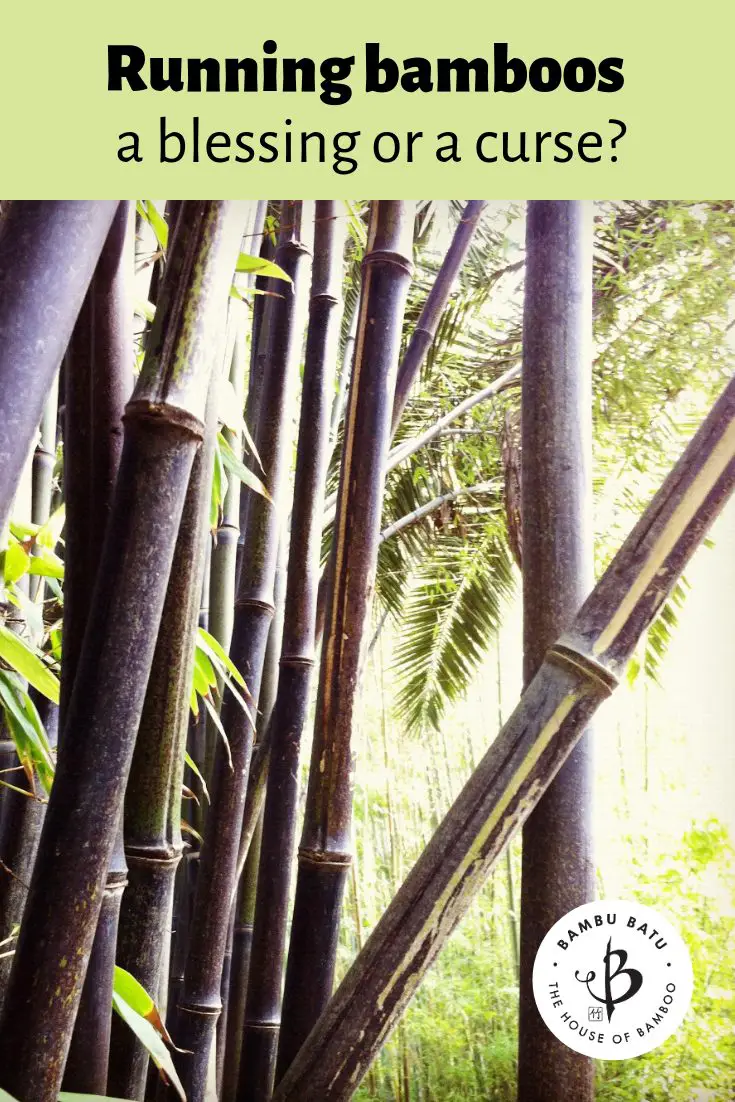

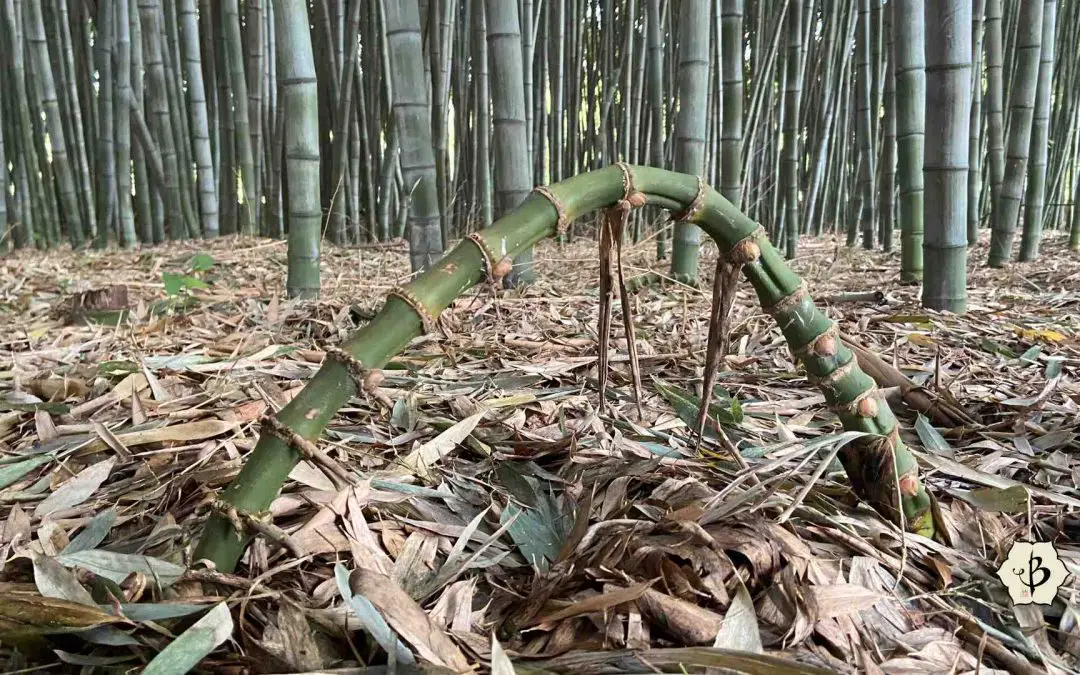
























I live in southern California about an hour east of Los Angeles. I want to grow a nice running bamboo about a block long along an ugly farm fence. The soil is rather sandy. The area is in direct sunlight. I want something that will look nice and grow fast. What do you recommend.
The most affordable option is probably Golden Bamboo. It’s easy to find, fast-growing and resilient. It has the classic appearance of bamboo. If you’re interested in other running types, with other distinguishing characteristics, check out the suggestions in our article on the best bamboos for your garden.
Don’t do it!!! It is so easy for it to get out of hand. I just spent over $2000 to remove mine. Save your money and piece of mind. Don’t plant it. Check out YouTube videos first!!!
Yikes! Sorry to hear that, Mary. That’s why many people prefer to plant clumping bamboos like Oldhamii.
I live in a rural farm area of southwest Missouri. Thinking about turning some runners loose on our property. We have 600+ acres with a creek running through it. Looking to generate a stand of sizeable 2 – 4 inch bamboo to be used on our farm. Any suggestions as to what species to plant and should I start with seed or go with live plants?
Bamboo seeds are hard to come by, and they can be challenging to propagate. Better to buy plants. Check out our resource list, and take a look at our article on Timber Bamboo. I’d recommend Henon or Madake, which are both discussed in that article.
don’t do it- you will regret it – it’s a horror – I wish I had never ever planted it. It will take over and IT WILL WIN.
It’s not for the faint of heart, but millions of gardeners and horticulturalists around the world revere bamboo for its beauty and utility.
Hi! Thanks for the fantastic resources and articles! Do you know anything about bamboos that would grow in the North-West of Spain, Galicia? It’s generally quite mild, with wet winters and windy/warm summers. Would you have any recommendations for both running and clumping options, please?
Yes, I’m currently based in Catalunya, where water is an issue. But Galicia has a better climate for bamboo, similar to the Pacific Northwest in the USA. Any running varieties should thrive there. If you prefer clumping, I’d try some varieties of Bambusa.